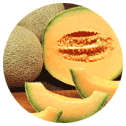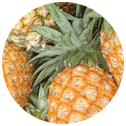 Full List of Fruits
Full List of Fruits  Feijoa Fruit
Feijoa Fruit
FEIJOA FRUIT
The Feijoa fruit, maturing in autumn, it is green in color, ellipsoid in shape and about the size of a chicken's egg like structure. It has a taste as sweet, aromatic flavor. The flesh is juicy and is separated into a clear jelly like seed tissue and a firmer, slightly gritty, opaque flesh nearer the skin. The Feijoa fruit drops when ripe, but can be picked from the tree previous to the drop to prevent bruising.
Introduction- Feijoa Fruit is increasing rapidly in demand throughout the world for its delicious, healthy qualities and adaptability. It has been expected that the Industry would spread to Australia, which has ideal growing conditions in many parts of the country. The feijoa fruit is also an egg-shaped fruit with a thin lime-green skin. The flesh inside is cream-colored and encases a jelly-like center. The texture is rough, close to that of a pear. The flesh tastes like a mixture of several other fruits, usually describe as pineapple, guava, and strawberry. Some people report a taste similar to that of a quince or lemon. Feijoa is native to South America, but is now commercially grown in New Zealand and California. It is also commonly called a pineapple guava.
Taste-Feijoa fruits are .75-3.5" in size long with green/blue-green waxy skin. The fruit taste like combinations of guava, pineapple, strawberry and mint. Both the flowers and fruit have a strong, pleasant scent.

Appearance- Feijoa keep well about one week before the quality of the fruit begins to suffer. When searching for the fruit, look for evenly colored, unbruised specimens, which should carry the distinctive sweet perfume. The Fruit feijoa almost looks like a Jack Fruit family with difference of taste. If chosen too early, feijoa will not ripen well off from the tree, so look for a fairly soft fruit. If exposed to too much warmth and humidity, the fruit will decompose under the skin, so be sure to ask about handling practices at your grocers.
Uses of Feijoa Fruit
A feijoa fruit can also be used as an interesting count to a fruit smoothie, and can be used to make feijoa wine or cider and feijoa infused vodka product in alcohol. It is also possible to buy Feijoa yogurt, fruit drinks, jam, ice-cream, etc. in New Zealand. The Feijoa can also be cooked and used as dishes where one would be use stewed fruit. It is a popular element in chutney.
The feijoa fruit, has a pineapple guava flavor, it is a tropical plant, native to Brazil. The feijoa shrub grows to approximately 15 feet and has pale gray bark with greenish gray rectangle leaves. The flowers are very flashy, in desert and white, and make a startling and sweetly scented addition to landscape. A Feijoa plant need prefers partial sun, with protection from extreme heat.
The plant is cultivated across Latin America, as well as in Australia and some part of the United States. In more northern areas of the United States, it is commonly used forlandscaping, because the plant itself is frost tolerant, but the fruit is not.
Current Facts:
Feijoa fruits are rich in vitamin C and have about 40 calories in four ounces of fruit. Eating five daily servings of fruits and vegetables lower the chances of cancer. A recent study of feijoa fruit found eating nine or ten daily servings of fruits and vegetables, combined with three serving of low-fat dairy products, were effective in lower blood pressure.
Today two important varieties are grown successfully in the cultivated areas. Called Triumph and Mammoth, the success of these two types of feijoa fruit is credited to Hayward Wright, a New Zealand nurseryman. Planting rootstock imported from New Zealand, today's feijoa growers are eager this fruit will be the next kiwi fruit.
10 Tips for Incorporating Figs in your Diet:
- Eat dries feijoa as a healthy energy snack. For extra flavour and nutrients, stuff them with nuts and a little honey.
- Add feijoa to baked goods such as muffins, cakes and muesli bars.
- Add dried or fresh feijoa to porridge, oatmeal or breakfast cereals
- Stew dried feijoa in fruit juice with other dried fruits to make a delicious fruit salad. Sprinkle with cinnamon and nutmeg before serving.
- Poach figs in red wine or fruit juice and serve with Greek yogurt or creme fraiche.
- Add quartered fresh figs to a salad of fennel, rocket and parmesan cheese.
- Stuff fresh figs with goat's cheese and chopped almonds and serve as an appetizer or dessert
- Make a fig butter by boiling dried figs in fruit juice until soft. When all the liquid has been absorbed, place the mixture in a food processor and blend until smooth. Use to spread on rice cakes, toast or crackers.
- Add chopped fresh figs to rice, quinoa or couscous dishes.
- Make a fig sharp by grinding two handfuls of walnuts in a food processor. Add one packet of dried figs, 1/2 packet raisins, 200ml apple juice, 1 tablespoon grated orange zest, 2 tablespoons honey and 1/2 teaspoon cinnamon. Process until the mixture is the texture of a sticky paste. Press into a pastry case and bake at a medium heat for 35 minutes.
| Nutritive value per 100 g of Feijoa | ||
| Principle | Nutritive value | |
| Total Fat | 0.2 mg | |
| Protein | 0.3 mg | |
| Carbohydrates | 3 mg | |
| Sodium | 1 mg | |
| Potassium | 44 mg | |
| Calcium | 4.8 mg | |
| Sugars | 2.7 g | |
| Dietary Fiber | 0.6 g | |
| Calories | 14 | |
1.Feijoa Salsa

- 3 feijoas, peeled and finely chopped
- 1 onion, peeled and finely chopped
- 1 Tbsp brown sugar
- fresh ground black pepper
Step 1:.Mix all ingredients together; purie if desired.
Step 2:Serve as a dip with tortilla strips, or as a topping for steak, fish, or chicken.
2.Tri-Color New Zealand Salad

- 5 ounces standard white flour
- 4 ounces butter, softened and cut into small pieces
- 3 tablespoon soft brown sugar
- 3 tablespoons ground almonds
- 2 large cooking apples
- 1 tablespoon caster sugar
- 1 1/2 tablespoons lemon juice
- 2 feijoas
- 2 ripe but firm bananas
- Custard, ice cream or cream, for serving
Step 1:Filter the flour into a basin. Drop the butter cubes into the flour and use two knife to cut it through the flour until the pieces of butter are like small marbles. Use your fingertips to stroke it through until the mixture resemble rude breadcrumbs. Blend in the sugar and almonds.
Step 2:Skin, core and piece the apples finely. Put in a basin and blend through the caster sugar and lemon juice. Skin the feijoas and slice coarsely. Add to the apples. Pieces the bananas thinly and add to the fruit. Mix gently together the mixtures. Tip the fruit into a buttered, shallow ovenproof dish. Shake over the crumble and touch down gently with the fingers.
Step 3:Heat with an stove preheated to 350°F for about 35 minutes, or until the apple is kind, the crumble is lightly browned on top and you can see the fruit juices sparkling through. If the crumble browns before the fruit is tender, loosely drape the top of the crumble with aluminum frustrate to deflect the heat. Serve with cream, custard, ice-cream or Greek honey flavored yoghurt.




















